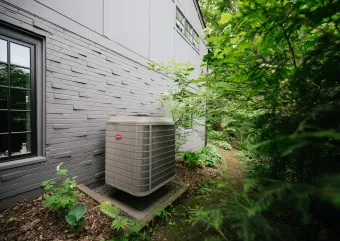Homeowners who use natural gas to heat their homes and are looking to reduce their household’s carbon emissions with an air source heat pump have two main options. Option one is to install a heat pump and keep a furnace for backup. This is called a dual fuel system. With this option, the heat pump heats the home until the outdoor temperature gets too low, at which point the heating source switches from the heat pump to the furnace. Option two is to install a heat pump with electric boosters to supply all heating and remove the furnace. This is called an all-electric system. While an all-electric system is possible, the more cost-effective choice is to use a dual fuel approach for homes using natural gas. A dual fuel system offers the best balance of reducing emissions while keeping energy bills low.
Dual fuel systems reduce emissions
Heat pumps offer a significant opportunity to reduce household emissions by electrifying part or all a homeowner’s heating needs. Heat pumps are essentially two-way air conditioners that use electricity to move heat energy between the inside and outside to provide cooling or heating. Electricity is becoming an increasingly cleaner source of heating than combustion furnaces because of the increasing renewable energy on the electric grid. And unlike traditional electric resistance baseboards or space heaters, modern heat pump technology is highly energy efficient. However, while an all-electric heat pump system will maximize emission reductions through cleaner electricity, it has high operational costs.
Conversely, a dual fuel system will still reduce emissions while being more cost-effective than an all-electric system. By switching to the furnace when outdoor temperatures are too cold (called the switchover temperature), homeowners can minimize energy bills while electrifying part of their heating.
For example, setting the switchover temperature to 45°F uses the heat pump for roughly 30% of the heating hours in a typical year. A switchover of 25°F uses the heat pump for roughly 56% of the heating hours in a typical year. While partial electrification with a dual fuel system reduces emissions less than an all-electric system, it is still a meaningful decrease from a furnace-only setup.
Dual fuel systems keep energy bills low
Dual fuel systems keep energy bills low by switching from the heat pump to the furnace at what is called the economic balance point. The economic balance point is the temperature at which it costs the same to heat a home with the heat pump as it does with the furnace. In a dual fuel system, the economic balance point considers the energy efficiency ratings of the heat pump and furnace, natural gas prices, and electric rates. According to CEE’s modeling, the economic balance point for homes to switch from a heat pump to a natural gas furnace is between 25°F and 45°F.
A dual fuel system set to the economic balance point uses whichever heating system costs less to run. Natural gas prices are often low but fluctuate. For example, natural gas prices in March 2022 were almost 50% higher than in March 2021. Electric rates by contrast are much less volatile and are the most constant of any fuel price.
Homeowners with a dual fuel system can change the switchover temperature to maximize savings as fuel prices change. If natural gas is expensive, the switchover temperature can be lowered so the heat pump provides more heating. If natural gas is cheap, the switchover temperature can be raised so the furnace provides more heating.
All-electric systems have their own type of economic balance point that considers the energy efficiencies of the heat pump and electric resistance backup. Because electric resistance heating is expensive to run, the most economic choice in an all-electric system is to have a high-efficiency heat pump capable of running to as low a temperature as possible before engaging the backup. While this setup makes the best use of energy in an all-electric context, the operational costs are notably higher when compared to a dual fuel or furnace-only setup in colder weather.
Another cost advantage of a dual fuel system is the option to keep the existing furnace; the furnace needs to be removed for an all-electric system. Dual fuel systems also have the potential to extend the life of the existing furnace. Furnaces are often designed to provide heat on the coldest days of the year. This design, however, can reduce heating performance in mild spring and fall temperatures, resulting in diminished energy efficiency, increased strain on the equipment, and negative effects on comfort. In a dual fuel system, the heat pump runs during mild temperatures, delivering more even temperatures and potentially increasing the furnace’s lifespan.
Dual fuel systems can work with more affordable heat pumps
Homeowners can choose between standard and high efficiency heat pumps when setting up a dual fuel system. Single-stage or two-stage heat pumps are considered standard equipment. They are more affordable but have less capacity to deliver heat in cold temperatures than high efficiency heat pumps. However, with the relatively moderate economic balance point for homes with natural gas (between 25°F and 45°F) a standard heat pump will work for a dual fuel system.
All-electric systems require high efficiency heat pumps to work. A subset of high efficiency heat pumps have a cold-climate rating and are often the best choice for an all-electric system. High efficiency heat pumps are more expensive but have additional benefits. They run quieter, hold steadier temperatures, dehumidify better, and use the least energy. High-end heat pumps are also more likely to qualify for rebates offered by utilities to help bring down the initial cost.
The choice depends on your goals
Both dual fuel and all-electric heat pump systems are great options to reduce household emissions. All-electric systems maximize this potential but will increase energy bills compared to dual fuel or traditional natural gas systems. Dual fuel systems offer a balanced approach of electrifying a portion of the heating without increasing energy bills.
Looking for more guidance?
To learn more about heat pumps, continue exploring News & Case Studies or visit the FAQs page. If you have further questions, contact us at info@mnashp.org.
Author
Connect with a local contractor


